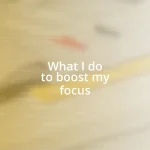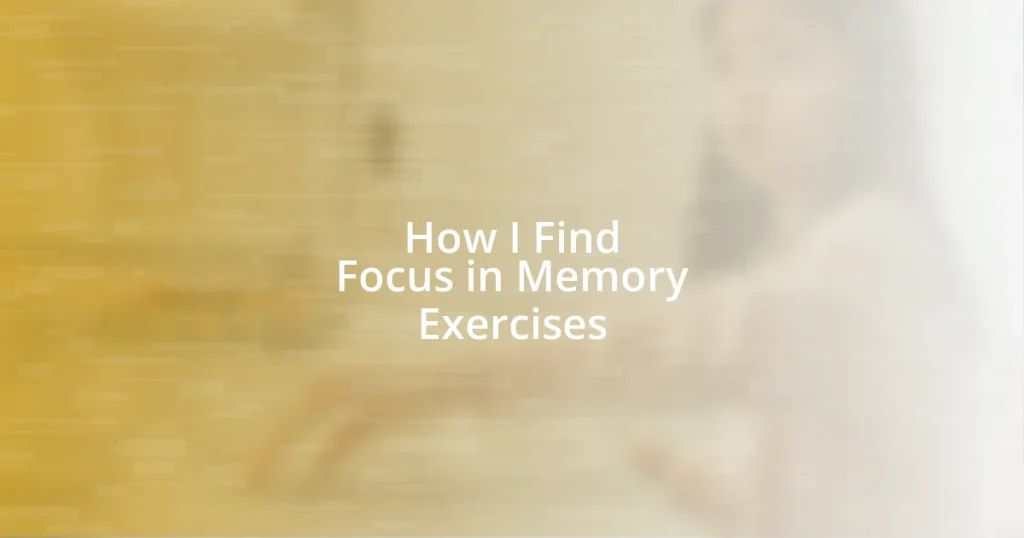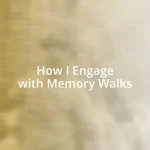Key takeaways:
- Creating a distraction-free environment and setting clear, actionable goals significantly enhance focus and retention in memory exercises.
- Incorporating regular breaks during study sessions revitalizes the mind and aids long-term retention of information.
- Adapting memory practices to personal learning styles and interests leads to a more enjoyable and effective learning experience.

Understanding Focus in Memory Exercises
When delving into memory exercises, I often reflect on how crucial focus is to the entire process. Have you ever tried to memorize something only to find your mind wandering? I distinctly remember a time when I attempted to learn a new language but struggled to retain vocabulary because my attention was divided by external distractions. That experience taught me that without harnessing focus, any memory technique becomes less effective.
Finding focus in memory exercises can sometimes feel like chasing a fleeting shadow. I’ve discovered that setting specific, distraction-free zones in my learning environment significantly enhances my concentration. For instance, I create a cozy nook with minimal noise and clutter, which helps my brain settle into the task at hand. It’s a small change, but it can completely transform how effectively I absorb and recall information.
Understanding how focus operates within the realm of memory training is pivotal. I’ve learned that it’s about quality over quantity; dedicating a shorter period with full attention can yield better results than longer sessions filled with distractions. How do you engage your focus? Finding your own rituals—like deep breathing or even a quick walk before tackling memory tasks—can be the key to unlocking your full potential.

Setting Clear Goals for Practice
Setting clear goals for practice drastically influences our efficiency in memory exercises. I vividly remember a time when I embarked on a memory challenge without a clear intention; I was frustrated and unproductive. However, once I defined specific goals, like memorizing a set number of words each week, I felt a sense of direction and accountability. This clarity not only kept me motivated but also made my practice sessions feel more fulfilling.
A pivotal moment for me came when I started breaking down my larger goals into smaller, actionable steps. For instance, instead of aiming to memorize an entire chapter, I focused on learning just a few key concepts each day. This approach reduced my anxiety and provided me with a sense of accomplishment with each checkmark on my to-do list. Have you ever experienced that overwhelming feeling when faced with a hefty task? By limiting my focus, I was able to sidestep that paralysis and maintain my enthusiasm for learning.
It’s remarkable how setting clear goals and tracking progress can transform one’s memory journey. I often reflect on the changes in my practice; it feels less like a chore and more like a personal growth project. Knowing exactly what I want to achieve—and watching myself succeed—fuels my passion for memory exercises even further. Engaging in the process with a clear roadmap is liberating. It’s an adventure I genuinely look forward to.
| Goal Type | Description |
|---|---|
| Short-Term Goals | Focus on immediate tasks, such as memorizing a few words or a brief passage each day. |
| Long-Term Goals | Set broader objectives, like mastering an entire subject by the end of the month. |
| Measurable Goals | Establish specific metrics to track progress, such as increasing recall speed or accuracy over time. |
| Challenging Goals | Pushing oneself outside the comfort zone, aiming for complex memory techniques or subjects. |

Establishing a Distraction-Free Environment
Creating a distraction-free environment has been one of the game-changers in my memory training routine. One time, while trying to memorize names for a networking event, I was surrounded by noise and clutter. I found myself repeatedly forgetting names, which made me feel embarrassed and even anxious. After that experience, I realized that such an environment inhibits my ability to concentrate. Now, I strive to set up a dedicated space, free from interruptions, where I can fully immerse myself in my memory exercises.
To create that ideal space, I focus on several key elements:
- Quiet Location: Choose a spot away from busy areas in your home or office.
- Minimal Clutter: Clear away any unnecessary items that could divert your attention.
- Comfortable Seating: Use a chair that supports good posture, making it easier to focus during longer sessions.
- Lighting: Ensure proper lighting to help reduce eye strain and create a pleasant atmosphere.
- Scheduled Time: Establish specific times for practice, eliminating distractions by informing others of your focus time.
By personalizing my space like this, I feel more in control and ready to tackle memory tasks head-on.

Using Visualization Techniques Effectively
Using visualization techniques effectively has been a revelation for me in memory exercises. I remember grappling with abstract concepts, feeling overwhelmed and disoriented. Then, I tried picturing those ideas as vivid images. This technique transformed my understanding; for example, when studying the solar system, I imagined planets orbiting around the sun. Not only did that make the information stick, but it also added an engaging layer to my practice. Have you ever tried turning words into images? It can be surprisingly effective.
I’ve also found that the more detailed my visualizations, the better the recall. One of my favorite methods involves creating a mental movie where I visualize myself interacting with the information. For instance, if I’m learning a new language, I picture myself in a market, using phrases and vocabulary in real-life scenarios. This kind of immersive technique not only aids memorization but also makes learning feel alive and relevant. How impactful would it be if you could see your knowledge in action?
Another essential aspect is to regularly revisit and refine these visualizations. Sometimes, I sketch them out or even create digital representations. By continuously refreshing the images in my mind, I keep the concepts vivid and engaging. Have you ever noticed how stale memories can become? By keeping my visuals dynamic, I maintain my focus and enthusiasm. It’s a personal journey that merges creativity with learning, making the process not just effective but truly enjoyable.

Incorporating Regular Breaks for Retention
Incorporating regular breaks into memory exercises has truly enhanced my retention. I vividly remember one particularly intense study session where I tried to power through without pausing. After an hour of relentless focus, I hit a wall; everything became a blur. It struck me that my brain was like a sponge – it could only absorb so much before needing to wring itself out. Now, I purposefully schedule breaks, typically around every 25 to 30 minutes. This short pause not only refreshes my mind but also gives me a chance to let that information settle.
During these breaks, I often step away from my study area. Whether it’s making a cup of tea or taking a brief walk outside, moving my body helps me clear my thoughts. Have you ever noticed how stepping away can provide a new perspective? I find that when I return, ideas and concepts feel more familiar, almost as if they’ve marinated in my mind. It’s remarkable how a simple change in scenery can breathe new life into my retention capabilities.
Moreover, I’ve started to treat breaks as mini rewards for my progress. After completing a challenging exercise, I indulge in something I enjoy, like listening to music or diving into a favorite book. Celebrating these small victories reinforces my motivation while keeping me engaged. Isn’t it fascinating how positive reinforcement can transform an arduous task into something enjoyable? By integrating breaks this way, I not only boost my focus but also find joy in my memory practice.

Tracking Progress Over Time
Tracking my progress over time in memory exercises has been both enlightening and motivating. I remember starting with a simple checklist, marking each completed session like a little badge of honor. It might seem trivial, but seeing those check marks accumulate instilled a sense of achievement in me. Have you ever felt that rush of satisfaction from simply accomplishing small goals?
As I continued, I decided to take it a step further by keeping a journal where I reflected on not just my performance but also my emotional state during exercises. It revealed patterns that I hadn’t noticed before—certain days felt significantly different than others. For instance, I realized that when I was mindful and present, my retention soared. Have you considered tracking not just the facts but also how you’re feeling while you learn? This insight helped me adapt my approach to suit my moods.
Reviewing my progress has also led me to set specific goals for improvement. After a few weeks of consistent practice, I challenged myself to increase my recall speed. I felt a thrill when I achieved that target, which in turn fueled my commitment to the exercises. It’s like hitting a personal best in a sport. How satisfying is it to see your hard work pay off? By recognizing these milestones, I not only celebrate my memory improvement but also build a more profound connection with the process itself.

Adapting Practices for Personal Needs
Adjusting my memory practice to fit my personal needs has been a game-changer for me. The moment I realized that not every method works for everyone was liberating. For example, I used to think that long study sessions were the standard. However, I learned that I work best with shorter, more focused bursts of activity, followed by engaged discussions with friends or family to deepen my understanding. Have you also found that experimenting with different approaches can lead to surprising discoveries about your learning style?
Another adaptation has been aligning exercises with my interests. I remember trying to memorize facts about history, and while the subject is captivating, the methods I used felt dry and uninspiring. Instead, I incorporated storytelling techniques, weaving facts into narratives that sparked my imagination. Suddenly, I wasn’t just memorizing; I was living the stories. Isn’t it interesting how connecting information to what you genuinely care about can transform your enthusiasm for memory work?
I also pay attention to the time of day when I practice. Mornings are my sweet spot for tackling challenging concepts. There’s something about that fresh, alert state that helps my mind absorb information like a sponge. Have you noticed a time when you’re naturally more focused? By tuning into my body’s rhythms and adapting my practice schedule accordingly, I’ve unlocked a more effective way to engage with my memory exercises.















